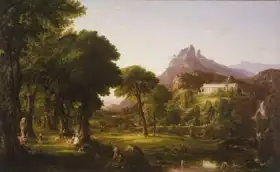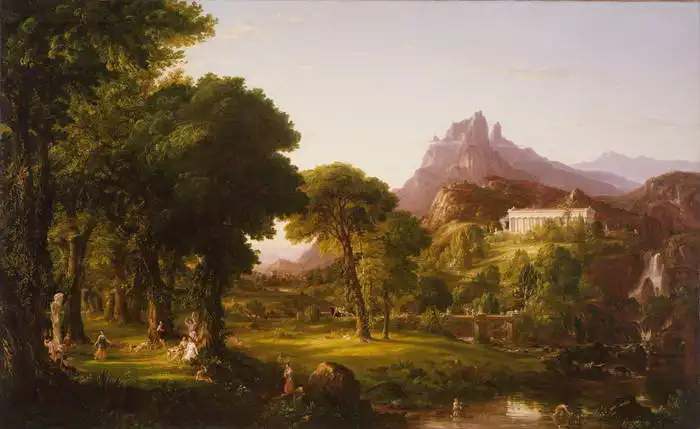About this finishing
Print. The image is printed on the top quality 10-ink HP Z9PS printer on HP matte 270 g / m2 paper. You can choose any size to an accuracy of 1 cm. A margin of 5 cm around the image is added to the size of the motif.


You can find a detailed description about our finishings
here.
Dream of Arcadia
"The Arcadian or Pastoral State" is an oil painting by American artist
Thomas Cole , who was known for his 19th century landscape paintings. This work was created in 1838 and is part of Cole's series of paintings entitled "The Journey of Life" (
The Voyage of Life: Youth ,
The Voyage of Life Manhood ), which depicts the various stages of human life, from childhood to old age. "Dream of Arcadia" represents one of these stages and can be understood as an allegory or symbolic representation of a certain period of human life. The painting depicts an idyllic pastoral landscape with picturesque hills, a river and green forests. This is a typical motif in Cole's landscape paintings, reflecting his interest in nature and his romantic notion of a wild and unspoiled landscape.
Thomas Cole was part of the Romantic art movement, which emphasized feelings, imagination and an emphasis on nature. "A Dream of Arcadia" is an example of this romantic style.
Prevailing color of this fine art print is green and its shape is long. This image is printed on demand - you can choose material, size and finishing.
Thomas Cole (1801-1848) was an American landscape painter of the
Romantic period. He born in England, but at age 17, his family emigrated to the United States. His father sold wallpaper. Cole travelled around Ohio and painted mainly portraits, with which he earned money. On the way to New York, he went on a trip down the Hudson River. He created a series of sketches of the mountains and surrounding nature, which were later transferred to the image
Indian Pass or
View of Two Lakes. These images sold quickly, and orders began to rain down on Cole. Therefore, he could travel to Europe for art. He travelled through Italy, mainly around Rome and Sicily. After his return, he continued in landscape painting and began making allegorical works -
Sen Arcadia. The best known is a five-part series of images mapping changing nature. Just before his death, he once more went to Europe. Much of his work is displayed in the Detroit museum.


